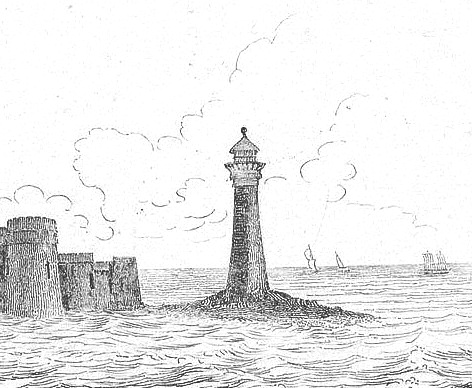Timeline
|
Events
/ Historic Developments
|
More material page or extra link
|
Area
|
|
1830 |
Opening of Liverpool and
Manchester railway gives Liverpool superb
communications with the rest of the country. |
|
|
1830 |
  The Perch Rock
Lighthouse, was built on a dangerous rock formation,
that the Lighthouse gets its name from. The rock is
also known locally as Black Rock. Perch Rock gets
its name from a tripod structure, known as a Perch.
The structure was a beacon fire, that was used to
mark the rock to shipping before lighthouses started
to be used. The
lighthouse is a The Perch Rock
Lighthouse, was built on a dangerous rock formation,
that the Lighthouse gets its name from. The rock is
also known locally as Black Rock. Perch Rock gets
its name from a tripod structure, known as a Perch.
The structure was a beacon fire, that was used to
mark the rock to shipping before lighthouses started
to be used. The
lighthouse is a wave washed tower similar in design to John Smeaton's Eddystone
lighthouse, standing 28.5 meter high.
The Lighthouse stands just behind the historic
Perch Rock Fort; a Napoleonic defence guarding the
river Mersey's mouth. wave washed tower similar in design to John Smeaton's Eddystone
lighthouse, standing 28.5 meter high.
The Lighthouse stands just behind the historic
Perch Rock Fort; a Napoleonic defence guarding the
river Mersey's mouth.
|
|
1832 |
A superior class of
hotel, Bold Arms, opens on Lord
Street in Southport. |
|
1832 |
The newspaper called the Liverpool Standard,
founded in this year. |
|
1833 |
The newspaper Liverpool
Saturday Advertiser shuts down. |
|
1834 |
Fire Police established
in Liverpool. |
|
1835 |
In Southport, the
sea wall was started to be constructed in order to
make the promenade, following flooding of parts of
the Town. The idea was to help protect
the town with the in sea defence as well as making
viable building land nearer the beach. The
design also included a watering hole near the sea. |
|
1835 |
In the Southport area,
Rev. Charles Hesketh was appointed as Rector of
North Meols in this year. |
|
1835 |
In Liverpool, a new
Custom House was opened. (It was later
to be destroyed in the bombing during the 2nd
World War.) |
|
1835 |
Everton, Kirkdale,
part of West Derby and some of Toxteth Park become
part of Liverpool. |
|
1835 |
Municipal Reforms Act,
this revises the Local Government and how it's run. |
|
|
1836 |
The rest of West Derby,
Toxteth, Walton and Wavertree all join Liverpool. |
|
|
1836 |
Liverpool Borough
Council set up its own Police Force. (09/02/1836) |
|
1837 |
The newspaper Liverpool
Mail founded. |
|
1837 |
Queen Victoria is
Crowned. |
|
|
1839 |
Lancashire Constabulary
formed in responsible for policing all parts of the
county. This was all the county except for
Liverpool and Manchester. (18/12/1837) |
|
|
1839 |
The newspaper Liverpool
Weekly Mercury founded. |
|
1840 |
The Royal Victoria Baths
constructed in Southport on the new promenade. |
|
1840 |
Cunard starts its
fortnightly service to New York with the steamship
Britannia, closely followed by Blue Funnel and White
Star lines. Liverpool Dock Trust puts lifeboat in
charge of the Harbour Master. |
|
1840 |
James Maury was the first United
States Consul in Liverpool and moves out of his
home, at 4 Rodney Street, Liverpool, in this year. |
|
1840 |
 With concerns over the
rising shipping in the area Southport's starts its
own sea rescue service, and has built a boat called:-
"The Rescue," this is before the RNLI
is set up. With concerns over the
rising shipping in the area Southport's starts its
own sea rescue service, and has built a boat called:-
"The Rescue," this is before the RNLI
is set up.
|
|
1841 |
Queen Victoria marries
Prince Albert. |
|
|
1841 |
Claremont House opened
to the public in Liverpool. |
|
|
1842 |
A survey of South-Port
says there are 1271 houses in the hamlet with a
population of 7774. Peter Hesketh Fleetwood earns
£214 per annum in rental from 14 acres of land in
the area. The census also pointed out that 87.8% of
the population of Southport attended church on the
census day. 30 years later the result was almost the
same. The census returns for this year says
there are 176 residents living in 30 houses, with 3
houses unoccupied. 22 of those occupied houses were
farms, and not counting the smith and the miller the
rest were agricultural labourers. |
|
1842 |
In Liverpool the
continued influx of impoverished families resulted
in horrific epidemics regularly sweeping through the
town's slums erected around the town centre.
Report on Liverpool's Sanitation concluded
"More filth, worse physical suffering and
moral disorder than Howard describes as affecting
the prisons, are to be found among the cellar
population of the working people of Liverpool." |
|
1843 |
Victoria Hotel, a very
prestigious hotel opened. |
|
1843 |
British illustrator John Callcott
Horsley invents the first Christmas card after being
commissioned by Sir Henry Cole. |
|
1844 |
Birkenhead Borough
Police was formed. |
|
1845 |
The newspaper Southport Visiter founded. |
|
1845 |
Ainsdale is a total size
of 1300 acres. |
|
1846 |
In Southport, Little Ireland well established by
this point, a den of drinking and fighting, with
only 5 privies serving the 100 or so people who
lived here. Assaults and serious wounding were the
norm for this area. Mrs. Hesketh choose to cleanse
the area by evicting the tenants, but this proved to
be a turbulent chore, but accomplished in the end. |
|
1847 |
 Prince Consort Albert
visits Liverpool and opens the Albert Dock complex.
Herman Melville, the author of Moby Dick, visits the
Albert Dock and compared the miles of docks with the
Great Wall of China and the Pyramids of Egypt. The
docks were so unprecedented that they were termed
the
"Modern wonder of the world." 1846.
Southport set up as a separate entity by an act of
parliament, now has town status. Prince Consort Albert
visits Liverpool and opens the Albert Dock complex.
Herman Melville, the author of Moby Dick, visits the
Albert Dock and compared the miles of docks with the
Great Wall of China and the Pyramids of Egypt. The
docks were so unprecedented that they were termed
the
"Modern wonder of the world." 1846.
Southport set up as a separate entity by an act of
parliament, now has town status.
|
|
1848 |
 In Liverpool, over
300,000 Irish poor landed in the port escaping
famine. Outbrakes of Cholera results in the
Liverpool Corporation appointing Dr Duncan to be the
first Medical Officer of Health in the country.
The influx of immigrants was identified by Dr Duncan
to be the course of the major outbreaks of
typhus fever. In this year over 21,000 people died,
that was one in fifteen of Liverpool's population. In Liverpool, over
300,000 Irish poor landed in the port escaping
famine. Outbrakes of Cholera results in the
Liverpool Corporation appointing Dr Duncan to be the
first Medical Officer of Health in the country.
The influx of immigrants was identified by Dr Duncan
to be the course of the major outbreaks of
typhus fever. In this year over 21,000 people died,
that was one in fifteen of Liverpool's population.
|
|
1848 |
In the Southport area a
survey of schools reports that there are 21 of them
in the area now, an increase of 15 from a similar
survey in 1826. |
|
1848 |
 William Rockloiffe becomes the coxswain on the
Southport Rescue boat. William Rockloiffe becomes the coxswain on the
Southport Rescue boat. |
|
1849 |
The 1st railway line
into Southport opens in this year, with the terminal
located on what is now Portland Street. |
|
1851 |
Mass burials were
regular occurrences with 572 deaths notified in one
week of August that year. |
|
1852 |
Census of Southport
during this year shows that of the 727 buildings in
the area 85 were lodging houses whilst further
visitors were accommodated in the 5 hotels and inns.
The census returns of this year confirm Ainsdale is
still a agricultural community, with a population of
only 176, of the 36 homes only 18 are farms whilst
the rest belong to agricultural labourers. |
|
1853 |
Sand Yachts
re-introduced to Southport beaches, after being
banned for several years due to a collision with a
bathing machine. |
|
1853 |
Nathaniel Hawthorne becomes the
Consul for the United States of America, at the
Liverpool - Paradise Street Consulate. |
|
1855 |
Northern Daily Times
founded. |
|
1855 |
During Whit week 40,000
people descended on Southport to enjoy the sun and
the beach. The Lancashire - Yorkshire Railway opens
in this year and has its terminal on Chapel Street.
Ormskirk Advertiser founded. |
|
1856 |
Liverpool Daily Post and
Liverpool Herald founded. |
|
1857 |
Liverpool Times &
Billinge's Advertiser and Liverpool Standard shut
down. |
|
1857 |
The last recorded Flying
Dutchman Ride was in Southport this year. |
|
1857 |
Nathaniel Hawthorne leaves the post
of the United States of America's Notable Consul,
from the at the Liverpool - Paradise Street
Consulate. |
|
1858 |
Cheshire Constabulary
was formed. |
|
|
1860 |
The toll-fee for walking
along the Southport Promenade is abolished when the
Improvement Council took over the maintenance of the
sea-wall and Promenade area. |
|
|
1860 |
Southport resident, Sir Charles Scarisbrick dies,
being one of the wealthiest commoners in
Lancashire. |
|
1860 |
The newspaper Southport Pier opened. |
|
1860 |
 RNLI takes over the
running of the Southport Lifeboat Station. RNLI takes over the
running of the Southport Lifeboat Station.
|
 The Southport Rescue
Lifeboat was taken out of service. The boat
had saved some 173 lives and a great many boats. The Southport Rescue
Lifeboat was taken out of service. The boat
had saved some 173 lives and a great many boats.
|
|
1860 |
The Rectory in
Southport was re-named the Rookery. |
|
1860 |
Altcar Rifle Range
Estate established in High Town, on the banks of the
River Alt and the beach near Formby Point. |
|
1860 |
Croxteth Halls East and
South wings added. |
|
1860 |
The newspaper called the
Seaside Tattler was founded. |
|
1860 |
First street railway in Britain started in
Birkenhead. The route it travelled was from the
ferry terminal in Woodside to Birkenhead Park. |
|
1861 |
in the Liverpool area,
it is recorded that 12,900 infant deaths, with 6,500
children under 5 years of age happened in this
year. |
|
1861 |
Thomas Haines Dudley becomes the
Consul for the United States of America, at the
Liverpool - Paradise Street Consulate. |
|
1861 |
The Widnes-Runcorn Railway Bridge is opened. |
|
1861 |
The newspaper Northern
Daily Times shuts down. |
|
1861 |
 The Jessie Knowles, the
replacement for the Southport Rescue Lifeboat is
launched. The Jessie Knowles, the
replacement for the Southport Rescue Lifeboat is
launched.
|
|
1861 |
The newspaper Southport Independent founded. |
|
1864 |
In Liverpool the City
Engineer's report listed 18,500 unsanitary houses
and over 3,000 congested courts. The populations
demand for cheap accommodation, and sanitary
conditions were thwarted by the increasing
population. |
|
1865 |
Liverpool has 4.7
million tons passing through the port. |
|
1865 |
Rev. Charles Hesketh
donates 30 acres of land to Southport for a public
park, with the following conditions, build a wall
around the park with four impressive gates, full
maintenance and build a road around the outside of
the park and connect the road with the rest of the
towns sewer system. And so was created Hesketh park
a high class residential area of Southport. |
|
1865 |
Southport grows and expands and absorbs Blowick
and High Park. |
|
1866 |
The newspaper Liverpool
Herald shuts down. |
|
1866 |
The Palace Hotel in
Birkdale opens. |
|
1867 |
The newspaper Liverpool
Weekly Courier founded. |
|
1867 |
Southport is
incorporated into a borough in this year. Also in
this year the Council had built the Cambridge Hall
next to the Town Hall, which provided the ideal
location for meetings and entertainment. 40% of the
3000 houses in Southport were private schools
looking for day-pupils. |
|
1868 |
In Southport, the Pier
extended making it 1470 yards long and able to
accommodate steamers which connected the town with
Barrow and Angelsey. |
|
1868 |
The newspaper Liverpool
Commercial Chronicle shuts down. |
|
1868 |
 The Runcorn
to Widnes
railway bridge was officially opened on 21 May 1868
and open for railway traffic on 10 October the same
year. The Runcorn
to Widnes
railway bridge was officially opened on 21 May 1868
and open for railway traffic on 10 October the same
year. |
|
1869 |
The newspaper Liverpool
Weekly Courier shuts down. |
|
1869 |
In Southport area, The
Wesleyans church is built in Ainsdale, on land
donated by Thomas Weld Blundell. |